Kürzlich fragte uns einer unserer Leser, wie ich die REST-API auf meiner WordPress-Website deaktivieren kann.
Als WordPress Version 4.4 veröffentlicht wurde, kam es mit der viel erwarteten JSON REST API. Während sie für Plugin-Entwickler großartig ist, finden viele Website-Besitzer sie vielleicht überhaupt nicht nützlich.
In diesem Artikel zeigen wir Ihnen, wie Sie die JSON REST API in WordPress einfach deaktivieren können.
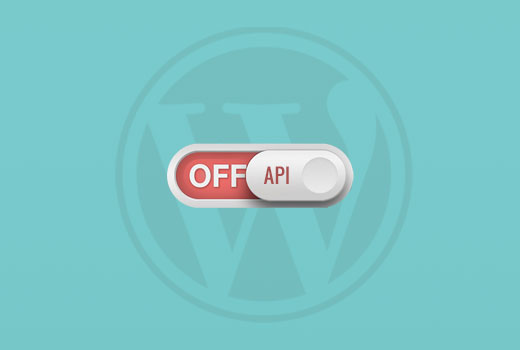
Warum JSON REST API in WordPress deaktivieren?
Es lässt sich nicht leugnen, dass die API viele Vorteile für WordPress-Entwickler hat. Die API macht es super einfach, Daten über GET-Anfragen abzurufen, was für die Erstellung von Anwendungen mit WordPress nützlich ist.
Dies könnte Ihre Website jedoch potenziell für eine neue Front von DDoS-Angriffen öffnen. Es kann auch ressourcenintensiv sein und Ihre WordPress-Website verlangsamen.
Die Deaktivierung von JSON REST API ist vergleichbar mit der Deaktivierung von XML-RPC, die viele Website-Administratoren auf ihren WordPress-Sites deaktivieren, um auf der sicheren Seite zu sein.
Wir zeigen Ihnen zwei Methoden zur einfachen Deaktivierung der JSON REST API in WordPress. Verwenden Sie einfach die unten stehenden Links, um zu der gewünschten Methode zu springen.
Methode 1. Deaktivieren der JSON REST API in WordPress mit Code (empfohlen)
Wir empfehlen die Verwendung des WPCode-Plugins, um JSON REST API in WordPress zu deaktivieren.

WPCode macht es sicher und einfach, benutzerdefinierten Code in WordPress hinzuzufügen, ohne die functions.php-Datei Ihres Themes zu bearbeiten. Auf diese Weise besteht kein Risiko, einen Fehler zu machen und Ihre Website zu zerstören.
Außerdem enthält es eine integrierte Code-Bibliothek mit geprüften Codeschnipseln für beliebte Funktionen wie Deaktivieren der REST-API, Deaktivieren von XML-RPC und vieles mehr. So müssen Sie nicht eine ganze Reihe von Plugins für den einmaligen Gebrauch installieren.
Um loszulegen, müssen Sie das kostenlose WPCode-Plugin installieren und aktivieren. Eine Schritt-für-Schritt-Anleitung finden Sie in unserem Leitfaden zur Installation eines WordPress-Plugins.
Hinweis: Die kostenlose Version von WPCode bietet alles, was Sie brauchen, um benutzerdefinierten Code in WordPress hinzuzufügen. Wenn Sie jedoch erweiterte Funktionen wie eine private Cloud-Snippets-Bibliothek, seiten- und gerätespezifische Snippets, Code-Revisionen und mehr wünschen, können Sie auf WPCode Pro upgraden.
Sobald das Plugin aktiviert ist, gehen Sie in Ihrem WordPress-Dashboard zu Code Snippets “ Library.
Suchen Sie dann nach dem Snippet „Disable WordPress REST API“ und klicken Sie auf die Schaltfläche „Use snippet“.
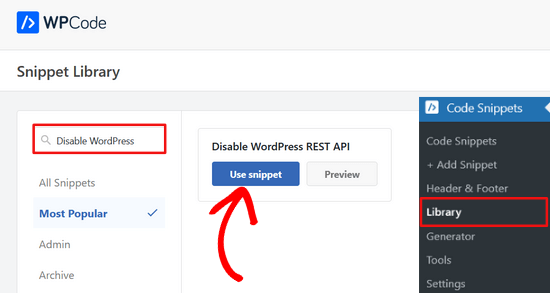
Das Plugin fügt dann automatisch den Code ein und wählt die richtige Einfügemethode.
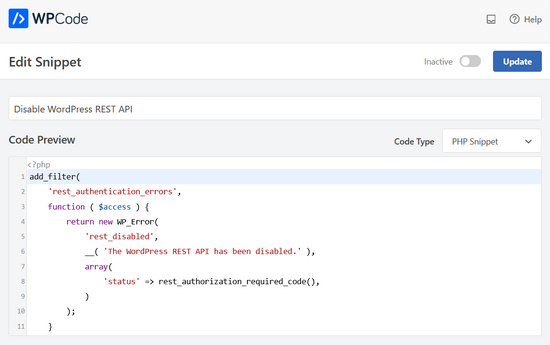
Dazu müssen Sie lediglich den Schalter von „Inaktiv“ auf „Aktiv“ umlegen.
Klicken Sie dann auf die Schaltfläche „Aktualisieren“.
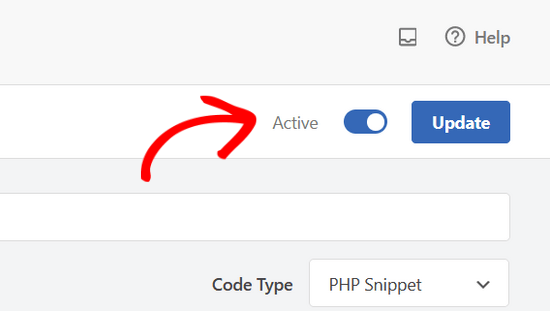
Das war’s. Jetzt ist die JSON REST API auf Ihrer WordPress-Website deaktiviert.
Methode 2. Deaktivieren der JSON REST API in WordPress mit einem Plugin
Als Erstes müssen Sie das Plugin Disable REST API installieren und aktivieren. Weitere Einzelheiten finden Sie in unserer Schritt-für-Schritt-Anleitung für die Installation eines WordPress-Plugins.
Das Plugin ist sofort einsatzbereit und es gibt keine Einstellungen, die Sie vornehmen müssen.
Bei API-Anfragen von Quellen, die nicht bei Ihrer Website angemeldet sind, wird nun zwangsweise ein Authentifizierungsfehler zurückgegeben.
Dadurch wird verhindert, dass nicht autorisierte Anfragen die REST-API nutzen, um Informationen von Ihrer Website abzurufen.
Sie können dies testen, indem Sie die Seite http://example.com/wp-json besuchen. Stellen Sie sicher, dass Sie sich zuerst aus dem WordPress-Administrationsbereich abmelden oder Ihren Browser in den Inkognito-Modus schalten.
Vergessen Sie nicht, example.com durch Ihren eigenen Domänennamen zu ersetzen. Sie sehen diese Meldung, die anzeigt, dass REST-API-Anforderungen blockiert sind.
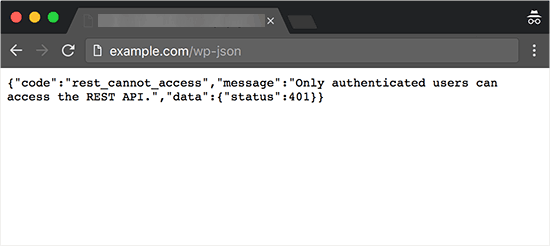
Das war’s. Sie haben erfolgreich nicht autorisierte REST-API-Anfragen auf Ihrer WordPress-Website deaktiviert.
Wir hoffen, dass dieser Artikel Ihnen geholfen hat zu lernen, wie man JSON API in WordPress deaktiviert. Sicherheitsbewusste Benutzer sollten sich auch diese Tipps zum Schutz des WordPress-Administrationsbereichs ansehen oder sich unsere Auswahl der besten WordPress-Backup-Plugins ansehen.
Wenn Ihnen dieser Artikel gefallen hat, dann abonnieren Sie bitte unseren YouTube-Kanal für WordPress-Videotutorials. Sie können uns auch auf Twitter und Facebook finden.





Syed Balkhi says
Hey WPBeginner readers,
Did you know you can win exciting prizes by commenting on WPBeginner?
Every month, our top blog commenters will win HUGE rewards, including premium WordPress plugin licenses and cash prizes.
You can get more details about the contest from here.
Start sharing your thoughts below to stand a chance to win!
RJW says
I’d try the disable plugin in Dev environment before production, I found installing it broke some features
WPBeginner Support says
If you have many different plugins and tools and have a testing environment then it would definitely be good to test new plugins and how they interact with your site.
Admin
Ricky says
Similar to an above commenter, I’ve noticed the „wp-json“ request when using Pingdom and other testing sites. Unfortunately, mine takes over 10 seconds (Yes really!!) to load it. This pushes my overall website load time and I can’t figure out how to fix this. The plugin doesn’t change it at all. Any suggestions?
Janice says
How do I know if I actually have JSON API on my website?
This article about removing it is good – if I need it – but I have often been alarmed by certain warnings only to find that they’ve not even applicable to me.
WPBeginner Support says
Hey Janice,
If you are using a self-hosted WordPress.org site, then you do have JSON REST API available on your website.
Admin
Logan Cale says
I hate adding yet another plugin to do a simple tasks, and I found that we can disable this functionality by adding the following code snippet to the functions.php file.
add_filter(‚rest_enabled‘, ‚_return_false‘);
add_filter(‚rest_jsonp_enabled‘, ‚_return_false‘);
Margarit Koka says
Thank you bro, your answer is what I was looking when visiting this page.
Bobby C. says
Thank you! Straight to the point.
Hari says
I was looking for this code, it worked, thanks, I don’t prefer adding plugins.
Michael says
Thanks for your help. There is no ‚add new‘ option in my plugins.
WPBeginner Support says
You are probably using WordPress.com. Please see our guide on the difference between self hosted WordPress.org vs free WordPress.com blog.
Admin
Lynne says
Thank you! Spot on worked for me
worked for me
J.L. says
Is this just for self hosted blogs or including free blog sites? Per mostly all plug ins…etc are done for you when you’re not self hosted
PS I’m not subscribing…just want a response
WPBeginner Support says
This is for self hosted WordPress.org sites only.
Admin
Elaine says
How can I check if my site has Rest API. I turned off a lot of extras when I first set it up but now don’t know where to look to see if it’s there. Not keen to download a plugin unnecessarily.
WPBeginner Support says
Hey Elaine,
You can check if rest is api is enabled on your site by visiting the url like this example.com/wp-json. Make sure you are signed out of WordPress before doing that. If you see lots of information in plain text, then this means REST API is enabled on your site. Follow the above instructions to turn it off
Admin
Saransh Jain says
What about the option to disable json rest api in Jetpack plugin?
Ken Dowling says
Is disabling REST API suitable for e-commerce sites such as WooCommerce? My understanding is that WooCommerce uses REST-API quite a bit.
Further, my buyers do not have to login to buy, so what happens to the transaction when a REST API call is rejected?
Regards, Ken
D. Joe Chaffin says
Plug-in makes no difference for me in WP 4.7.2. With the plugin activated or disabled, the example.com/wp-json (with my domain replacing „example“) pages gives a massive list of settings for my site.
D. Joe Chaffin says
Hmmmm. Now that I look at it, I only see the list in Safari, while Chrome and Firefox for Mac show the expected message specified in this post.
WPBeginner Support says
Hi,
Make sure you are logged out of WordPress admin area or use incognito mode before testing the example.com/wp-json page. The plugin disables access to the page only for unauthorized users. As an administrator you will still be able to see it.
Admin
D. Joe Chaffin says
Embarrassed… You are right, of course.
Audra Carpenter says
Hey Guys,
First off thanks so much for what you do! I’ve learned so much about WordPress from you and sent a ton of folks your way!!
Ok, I installed the plugin, but I am not seeing what you suggest above? I have a full screen of information…?
Thoughts?
Thanks!
WPBeginner Support says
Hi Audra,
Please logout or use incognito window to test. The plugin only disables access for non-logged in users.
Admin
Treasure says
I followed these steps, but when I went to check it with the example etc., I got 2 pages of code, not the response showed above. Hmmm, don’t know what to do.
Treasure says
Alright, I did it again and got the right message. Thanks!
Doug Nix says
When I ran the test I think it failed, as I got a boatload of data on screen. Any idea what might have not worked? I installed the plugin as described…
Doug Nix says
Works perfectly when I check using an incognito window. Thanks for the explanation regarding authorised vs unauthorised or anonymous users.
Laura Zielke says
Worked perfectly. Thank you!
Karl says
Thanks for the tip as well as for the hook to disable XMLRPC.
Is there a chance for a filter hook for the REST API as well?
Andrew says
When I check the speed of my site using pingdom.com, the first html entry that tried to load shows the link as mydomain.com/wp-json and it has over 2 seconds of „wait“ time. Is this the same as what this article is talking about? I’m hesitant to simply disable it since I would assume it will be used in the future. Any idea why it would add a 2+ second delay to loading anything on the page?
Stephen Cronin says
Hmm, the REST API is going to become the standard way for plugins and themes to make Ajax calls back to the server from the front end, replacing admin-ajax, so I wouldn’t be disabling it… Hopefully they will fail gracefully, but you will almost end up missing some functionality.
Also, if you really want to protect against DDoS attacks, you better disable html as well!
reza says
ver 50,000 WordPress websites have been hacked due to a major security vulnerability that was discovered in the WordPress REST API.
Jim S Smith says
OUCH!
That’s disturbing to know. I have noticed a LOT of access attempts in my site’s logs.
What’s more,
I think the folks at WordPress could have done a little better in letting the users decide how much, if at all, they want the REST API exposed.
Again,
More of this, „The developers know MORE about the user’s needs than the user does!“ – I also was not too happy about being forced to support EMOJI and remote-loaded fonts from fonts.google.com, even though my sites do not use them!
The REST API may be a boon for (some) actual web-application developers, but what about the rest of us who will not very likely use this? ? ?
Kasey says
How likely is it that a plugin will be using this functionality. Just for example would contact forms be utilizing this? Not keen on turning it off in case it breaks anything.
WPBeginner Support says
The plugins will most likely notify you if they will be using it and you have it turned off.
Admin